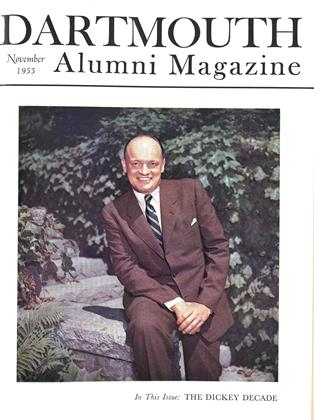ByRobert O. Blood Jr. '42. Glencoe, Illinois:Free Press, 1955- 842 pp. $5.00.
Many books have been written on the subject of marriage and the family. This is an index of the great importance of this field of knowledge. It may well be asked - What does this book by Prof. Blood offer the reader that is new or particularly valuable? The answer of the author that his book "offers a fresh synthesis of the best available subject matter plus specific innovations derived from the author's teaching, counseling, and research experience" is no overstatement.
In view of the major shifts in American sexual behavior that occurred at the end of the First World War, marking also the end of an era for American families, the author claims that the old answers are not sufficient any more. "Although the traditional marriage pattern still holds sway in some quarters, it is no longer generally accepted in America as the code which everyone should follow." As a result of this new situation the author is of the opinion that to-day's young people anticipating marriage can less easily foresee what they are 'getting in for' than could their grandparents. Hence there is the need for preventive education to avoid possible denouement to their marriage as well as for reliable marriage education as a means to a more satisfying marriage. Prof. Blood's book admirably fulfills this two-fold need by supplying the prerequisite knowledge and skills for making difficult choices and decisions that every individual now must make during courtship and marriage.
In Part I of the book, Courting, the reader is taken through the following steps: dating, choosing a marriage partner, narrowing the field and finding the right person, growing in love, giving physical expression to love, including types of individual sexual activity as necking, petting, premarital intercourse, etc. In Part II, Marriage, one reads about the wedding and honeymoon, including criteria for the honeymoon and its functions, learning to act as husband and wife, solving marriage problems, which inevitably spring up, by means of suggested prerequisites for such problem-solving, counseling when divorce looms, achieving sexual satisfaction in marriage, managing the family finances, etc., etc. In Part III, Parenthood, the reader gets help in deciding when to have children, learning to live with them and guiding their growth, and what to do with regard to sex education and religious education. Part IV, Family Living, concludes the book with consideration of such matters as enjoyment of family living, companionship, the family life cycle, and, finally, how to choose a neighborhood and how to get along with the neighbors and keep up with the Joneses.
The book obviously deals with many intimate matters. It does so with perfect candor and with an occasional touch of humor. As one might have reason to expect, Prof. Kinsey's findings are drawn on for much material. But more than that, the best current available material from sociology, psychology, biology and related fields give the reader trustworthy knowledge for his own use. The introduction of abundant case material provides valuable reading matter that is full of human interest.
 View Full Issue
View Full Issue
More From This Issue
-
 Feature
FeatureSome Presidential Thoughts Selected from Addresses and Writings ...
November 1955 -
 Feature
FeatureTHE REASONS Behind Corporate Gifts to Dartmouth
November 1955 -
 Feature
FeatureThe Convocation Address
November 1955 -
 Feature
FeatureA Review of Major College Events
November 1955 -
 Feature
FeatureSome Moments Caught by the Camera
November 1955 -
 Article
ArticleFootball
November 1955 By Cliff Jordan '45
RALPH P. HOLBEN
-
 Books
BooksThe Drifting Home,
FEBRUARY, 1927 By Ralph P. Holben -
 Books
BooksWholesome Marriage.
FEBRUARY, 1928 By Ralph P. Holben -
 Books
BooksOUTDOOR RECREATION LEGISLATION AND ITS EFFECTIVENESS
JUNE 1930 By Ralph P. Holben -
 Books
BooksMARRIAGE.
April 1933 By Ralph P. Holben -
 Books
BooksTHE TRIAL OF BRUNO RICHARD HAUPTMANN
March 1938 By Ralph P. Holben -
 Books
BooksTHE STORY OF BLINDNESS.
July 1956 By RALPH P. HOLBEN
Books
-
 Books
BooksMAN AND THE COMPUTER
JANUARY 1973 By J. MICHAEL TURNER '66TH -
 Books
BooksFRANCE-NORD. VOLUME I. ARTOIS. ESTRÉE-BLANCHE. LA REGION D'AIRE ET AU-DELA. HISTOIRE. HABITANTS. HISTOIRES.
MAY 1972 By JOHN HURD '21 -
 Books
BooksTHE STRANGEST BOOK IN THE WORLD:
MARCH 1964 By JOHN W. ZARKER -
 Books
BooksTHE LONELY CRO WD: A STUDY OF THE CHANGING AMERICAN CHARACTER
April 1951 By KENNETH A. ROBINSON -
 Books
BooksLANDS OF EUROPE AND ASIA.
MAY 1959 By MARGARET KLAYBOR -
 Books
BooksISLAMIC CONTRIBUTIONS TO CIVILIZATION.
APRIL 1964 By ROBERT G. LANDEN

